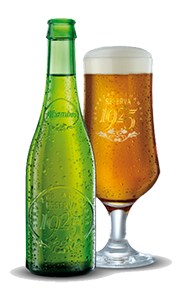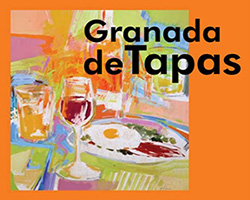- Home
- Granada Guide
- Eat in Granada
The Tapas
Although they may not be the most outstanding aspect of local cuisine, tapas that are served free in all the bars of the province along with the wine flat or the beer cane are an appetizing symbol of Granada that awakens the senses and is recorded in the memory of the visitor. Miniature cuisine, tapas are in themselves an informal way to have lunch or dinner in a varied and tasty way.
The tapas in bars and bars is for the Grenadian an indispensable social rite. In more or less abundant quantities, the kitchens give away the palate of their customers with dishes of stewed snails, potatoes to the poor, battered fish and roasts in sauce, to name a minimum representation.
 Download the Granada tapas guide
Download the Granada tapas guide
A little history of tapas
It is assured that it was King Alfonso X "The Wise" who arranged that wine was not served in the inns of his kingdom if it was not accompanied by some food. This prevented the wine from rising quickly to the head.
The lid, at the beginning, was deposited on the mouth of the pitcher or glass served, so the container was "covered": hence the origin of the word. It served to accompany the drink and to prevent any "flying visitor" from entering the precious liquid. In those days the lid consisted of a slice of ham or sliced sausage or other sausage and, sometimes, was replaced by a wedge of cheese.
Gastronomy
Grenadian cuisine with capital letters is as varied and appetizing as tapas. It is a cuisine with a great Arab heritage, generous in spices, rich in soups and stews and especially sweet tooth. The products of the fertile Vega that surrounds the city of Granada are the basis of many of the typical local dishes, such as tender fried beans with ham, stuffed chard pencas, thistles, pipirrana and the indispensable gazpacho. Renowned specialty in the capital is Tortilla del Sacromonte, a dish not suitable for primed palates that is made with marrow, brains, veal and eggs.
The cold weather that the white peaks of Sierra Nevada impose during the winter has led to a kitchen of hard dishes to comfort the body and spirit. The best example is the traditional Pot of San Antón, so blunt that it is eaten only for a couple of weeks a year. In his avio, few parts of the pig escape: ear, tail, bacon, blood sausage, handyman ... accompanied with dried beans, rice and fennel. Of the Marquesado and the Altiplano are the typical paprika porridge, the breadcrumbs, the stews of lamb and the fried choto with garlic.
The gastronomy of the Alpujarra is in itself a tourist attraction. Monumental is Trevélez ham, cured in the highest town of the Iberian Peninsula. Although it is obtained from white pigs, its quality has gained such fame that it is being highly demanded by the always demanding Japanese market. This delicacy is never lacking in the most reputable dish of the region, the Alpujarreño Dish, a specialty that is completed with loin, sausage, blood sausage, fried eggs and poor potatoes. Its forcefulness demands to accompany it with a Clarete wine from the Contraviesa, or if desired, one of the most elaborate wines that some adventurous winemakers have successfully managed to take to the terroiro.
The Costa Tropical also guarantees good fish and seafood at the Granada tables. Of exceptional quality are Motril's white crayfish, crayfish and prawns, which only require an iron stroke to sublime their flavor. Also grilled or buried in salt are very fine fish such as snapper, sargo, gilthead sea bass and sea bass. And roasted in spit or moraga, sardines.
The enviable climate of the Granada coast has led to the cultivation of subtropical fruits, such as custard apple, avocado, mango and carambola. The digestive culmination of all food can be put a sip of Motril rum, of surprising quality to be raised so far from Caribbean lands.
Desserts

Honey and spices are essential ingredients in the Granada pastry, of Arab heritage. Paradoxically, it is the sweets made by the nuns in the cloistered convents that have achieved more popularity: biscuits, moll eggs, mantecados and fruit compotes. Delicious are the sky tocinillos of Guadix, the ross of Loja and the fig bread of the Alpujarra. The Piononos, some small candies with the name of Pope, deserve a visit to Santa Fe alone.
Drinks: Wines, Beer and Rum

The gastronomic variety of Granada must be accompanied with the wines of the region. These include those of the Contraviesa, Albondón and Albuñol, ranging from wines with solera and high graduation, to modern, young and fruity wines, light and balanced.
We must not forget the beer tradition of Granada, and for this we must mention a beer that has been made in the city since 1925, the Alhambra Beer.
It is said that the oldest rum comes from Granada. The sugar cane was brought by the Arabs to Europe through Spain and cultivated mainly in the southern coasts, to obtain sugar. When Christians conquer the Nasrid kingdom of Granada, they think of making a liquor with the sweet cane juice. The Spaniards took the cane to Cuba, where the climate was much more appropriate and the production, both of sugar and rum, was made in America.
The "Pálido Montero" rum (Francisco Montero Martín), well known in Granada, is still elaborated in motril, completely handmade rum distilled in the Montero stills, with its ancestral formula they make it a unique product in the world and that today only a minimum amount is produced in the Costa Tropical of Granada (in the 5 Km that separate Motril and Salobreña).

